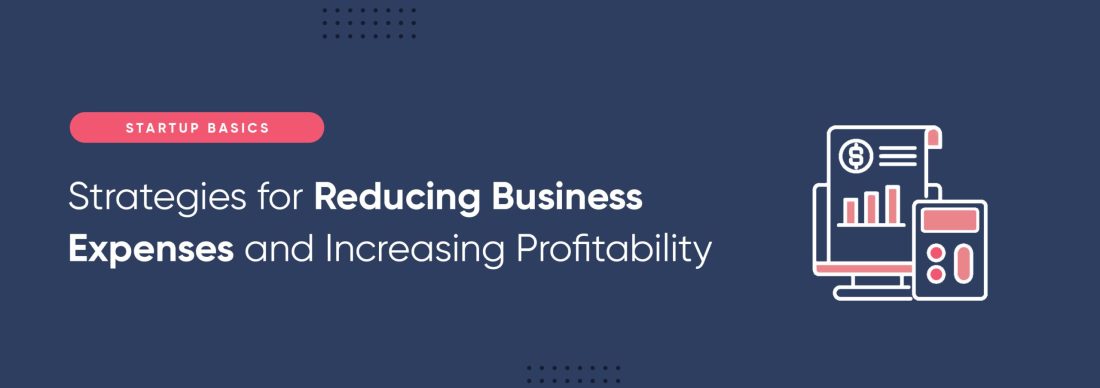Strategies for Reducing Business Expenses and Increasing Profitability
May 18, 2023 | 12 Min Read


Jump to Sections
Stay updated
with our Blogs
We will keep you updated about our latest blogs
Share This Blog
Importance of Reducing Expenses and Increasing Profits
Prior to developing a strategy to reduce expenses and increase profits, it is essential to understand why this must be done.
Reducing expenses can help improve your bottom line while also freeing up cash that can be reinvested elsewhere in the business or kept aside as a buffer for difficult times. Additionally, a healthy bottom line can make the business more attractive to potential investors, lenders, or buyers.
Analyzing and Categorizing Business Expenses
The first step in expense management is to determine where the cash is being utilized. By categorizing and analyzing each expense, businesses can identify areas of potential cost savings, while simultaneously making informed decisions regarding the effective allocation of resources. One should consider using accounting software or hiring accountants for small businesses to ensure their financial reporting is accurately maintained.
The following are some of the typical expense categories for small and medium-sized businesses:
- Cost of goods sold (COGS): This is the summation of all direct expenses related to the production and/or sale of goods, such as raw materials, manufacturing, and shipping costs.
- Operating expenses: This includes all expenses related to the day-to-day operations of the business, such as rent, utilities, office supplies, and marketing.
- Personnel expenses: This category includes all expenses related to the salaries of employees, benefits, and payroll taxes. It also includes expenses related to hiring and training of new staff members.
- Depreciation and amortization: This includes all expenses related to the wear and tear of assets over time, such as buildings, machinery, equipment, and vehicles.
- Finance expenses: This includes all expenses related to financing activities, such as interest payments and bank fees.
- Taxes: This includes income tax, sales tax, property tax, and any other tax that needs to be paid by the business.
- Other expenses: This includes any other expenses that do not fit into the above categories, and which can include travel, insurance, and legal costs.
Once expenses are categorized, businesses can then analyze each category to identify areas of potential cost savings. For example, a business may identify that it is spending too much on personnel expenses and may look for ways to reduce employee turnover or find more cost-effective payroll solutions.
Cost-Cutting Strategies for Operational Expenses
- Process automation: Automating time-consuming and repetitive tasks may result in significant cost and time efficiencies. Consider using automation tools and software to streamline processes such as bookkeeping and accounting. Reducing paper usage through automation can help save on printing and mailing costs by using online billing, digital documents, and electronic signatures.
- Switch to cloud-based software: Switching to cloud-based software can reduce the cost of procuring, as well as the maintenance of hardware and software. It can also offer greater flexibility and scalability for businesses to adjust resources based on demand.
- Reduce energy consumption to lower utility bills: Implement measures to save energy such as turning off lights and equipment when not in use and investing in energy-efficient lighting and equipment as well.
- Implement cost controls: Implementing cost controls such as spending limits and purchase approvals can help prevent overspending.
- Renegotiate contracts: Businesses can renegotiate contracts with vendors to get more competitive rates or find more cost-effective alternatives. They may also renegotiate rent agreements or even find a more affordable office space.
- Outsourcing non-core functions: Outsourcing non-core functions such as accounting, human resources, and customer service can save money on staffing costs and help businesses focus on their core competencies.
Want to learn about the next steps for growing your business ?
Personnel Expense Reduction Strategies
In many cases, a hefty portion of your budget is likely to be utilized on personnel expenses. However, there are several strategies businesses can use to cut down on these costs, while simultaneously maintaining productivity and quality of the workforce.
- Hiring freeze: Restricting new hiring can be useful when the business is hindered by a slowdown in the economy or when revenues are contracting.
- Reduce overtime: Overtime pay can quickly add up, increasing personnel expenses immensely. To reduce overtime costs, businesses can limit overtime hours or hire part-time employees.
- Flexible work arrangements: Allowing a flexible work environment such as working from home can reduce commuting costs, as well as office rent and other office-related expenditures such as furniture.
- Cross-train employees: Cross-training employees will result in greater employee competencies as existing employees can be loaned to other departments.
- Additionally, consider providing professional development opportunities in order to retain top organizational talent, lowering employee turnover figures.
- Performance-based pay: Implementing performance-based pay can encourage employees to work more productively, reducing the need for additional staff.
- Outsourcing: Outsourcing non-core functions such as payroll solutions and human resources can reduce personnel expenses by eliminating the need for additional staff.
However, it’s important to ensure that personnel expenses are not reduced to the point of negatively impacting employee morale and job satisfaction.
Revenue generation strategies
In addition to cutting expenses, businesses can also focus on increasing revenue to improve their bottom line. Here are some effective revenue-generation strategies:
- Increase prices: One of the most effective ways to increase revenue is to increase prices. However, the success of this strategy would require extensive market research to determine the competitiveness of the planned new price to ensure that volumes are not severely impacted. Significantly lower volumes may contradict the revenue growth plan to the extent that sales depict a negative trend.
- Expand product or service offerings: Developing new products or diversifying existing offerings can help attract new customers and generate additional revenue. Upselling and cross-selling can also increase revenue by encouraging customers to purchase more products or services. For example, a customer purchasing a mobile phone may also be interested in purchasing accessories such as a case or screen protector.
- Target new markets: Revenues can also be increased by expanding the customer base. Businesses can target new markets such as expanding into maiden geographic regions for business or targeting a different demographic audience.
- Launch a loyalty program: Implementing a loyalty program can incentivize and result in recurring customers. Offering discounts or rewards to loyal customers can encourage them to purchase more frequently.
- Improve marketing efforts: Improving marketing efforts such as social media marketing, content marketing, as well as search engine optimization can increase brand awareness and attract new customers, which can also lead to increased revenue.
Negotiation Strategies with Suppliers and Vendors
Negotiating with suppliers is an important part of managing business expenses and increasing profitability. This might include renegotiating contracts or finding more affordable alternatives. Consider purchasing in bulk to receive discounts or asking for lax payment terms to improve your cash flow.
Below are some effective negotiation strategies:
- Research and preparation: Before entering negotiations, it is necessary to gather information about supplies, such as product offerings, pricing, and competition. It is vital that the management highlights the needs of the business during contract negotiations to get the best deal possible for those products.
- Leverage competition: Use competition to your advantage by identifying other suppliers or vendors who offer similar products or services. This can help negotiate better pricing or terms by presenting the supplier or vendor with a viable alternative.
- Be flexible: Negotiations are often a give-and-take process, so be willing to compromise on non-essential items in exchange for better pricing or terms on essential items.
- Build a relationship: Building a good relationship with suppliers or vendors can help you negotiate better pricing or terms in the long run. This can be achieved by being a reliable and consistent customer, paying invoices on time, and communicating effectively. Long-term contracts can also help achieve better terms as long as they align with the business’s long-term objectives.
How Accountimize Can Help
At Accountimize, we recognize the importance of reducing expenses and improving profitability for the success of any business, regardless of size.
Our team of experienced CPAs can assist in analyzing and categorizing business expenses, provide insights into cost-cutting strategies for operational and personnel expenses, and help in implementing revenue generation techniques to enhance the business’ profitability.
If you are looking for accountants for small businesses that can help with your financial reporting requirements and payroll solutions, book a call with us today so that together, we may grow your business and achieve your financial goals.
Book a Discovery call


Stay updated
with our Blogs
We will keep you updated about our latest blogs



